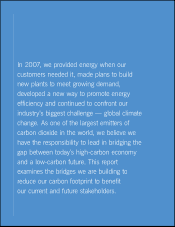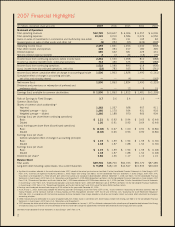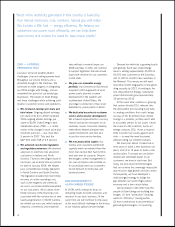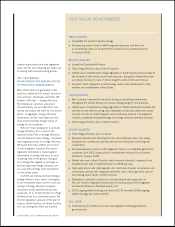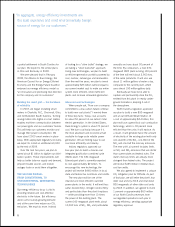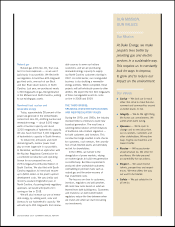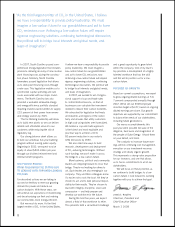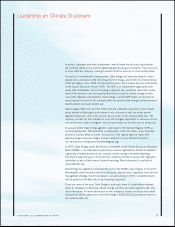Duke Energy 2007 Annual Report Download - page 6
Download and view the complete annual report
Please find page 6 of the 2007 Duke Energy annual report below. You can navigate through the pages in the report by either clicking on the pages listed below, or by using the keyword search tool below to find specific information within the annual report.
4
2007 — A STRONG,
PRODUCTIVE YEAR
Last year, we faced weather-related
challenges of record-setting summer heat
throughout our service territory and a
persistent drought in the Carolinas. We
continued to make progress in integrating
our 2006 merger with Cinergy, and we
completed the spinoff of our natural gas
businesses. The people of Duke Energy
met these challenges while achieving solid
results in customer service and operations.
We increased earnings per share and
total return: Ongoing diluted earnings
per share of $1.24 in 2007 exceeded
2006 ongoing diluted earnings per
share of $0.99. Duke Energy’s total
shareholder return (TSR) — a combi-
nation of the change in stock price plus
dividends paid out — was more than
9 percent in 2007. This beat the
S&P 500 index TSR of 5.5 percent.
We achieved constructive legislative
and regulatory outcomes: We received
approvals to build two new advanced
coal plants in Indiana and North
Carolina. Thanks to the diligent work of
our teams, we received final air permits
for both in January 2008. We helped
pass comprehensive energy legislation
in North Carolina and South Carolina.
The legislation enables the more timely
recovery of certain operating costs,
such as the reagents and chemicals
we use in our environmental equipment
on our coal plants. And it allows more
timely recovery of the financing costs
associated with the construction of new
baseload generation. In North Carolina,
we settled our rate case, which reduced
industrial, commercial and residential
■
■
rates without a material impact on
2008 earnings. In Ohio, we continue
to support legislation that will ensure
future rate certainty for our customers
in that state.
We grew our renewable energy
portfolio: Our Commercial Businesses
acquired 1,000 megawatts of wind
power assets planned or under
development in the western and
southwestern United States. We
also began construction of two small
hydroelectric power plants in Brazil.
We dedicated ourselves to customer
service and economic development:
We achieved improvements in our key
internal satisfaction measures for all
customer classes. Economic develop-
ment efforts helped stimulate new
capital investments and new jobs
in our five-state service territory.
We met productivity targets: Our
nuclear and coal plants performed
superbly when we needed them the
most. Our nuclear fleet had its third-
best year ever for capacity. Despite
the drought, careful management of
our coal and hydro units enabled us
to successfully meet our customers’
record demand for both peak and
baseload power.
BUILDING BRIDGES TO
A LOW-CARBON FUTURE
In 2008, we’ll continue to focus on
delivering results for both customers and
investors in our basic business. At the
same time, we will continue to chip away
at the most difficult challenge in the history
of our industry: global climate change.
■
■
■
Demand for electricity is growing locally
and globally. Each year, Duke Energy
alone is adding approximately 40,000 to
60,000 new customers in the Carolinas,
and 11,000 to 16,000 new customers in
the Midwest. This means we will need
more than 6,000 megawatts of new gener-
ating capacity by 2012. According to the
U.S. Department of Energy, nationwide
power demand will grow approximately
35 percent by 2030.
At the same time, evidence is growing
that carbon dioxide (CO2) released into
the atmosphere from burning fossil fuels
is creating conditions that could change
our way of life. Scientists know climate
change is a problem, yet they aren’t able
to accurately predict its full scope. I leave
the science to the scientists, but as an
energy company CEO, I have a responsi-
bility to protect our assets against such
risks — to meet the need for power,
without risking our children’s futures.
We must plan ahead. It takes five or
more years to build a new baseload coal
plant, and 10 to 15 years to build a new
nuclear plant. To ensure we can deliver
reliable and affordable power to our
customers, we have to start now. But
today, we lack advanced technologies
that can achieve this seemingly impossible
dual mission: high growth and low carbon.
Consequently, we have developed a
multi-pronged strategy to bridge the
gap between our current high-carbon
economy and a low-carbon future.
Let me explain in this letter how the
people of Duke Energy are building four
bridges: (1) from “production” (making
watts) to “efficiency” (saving watts);
(2) from conventional to unconventional
generating technologies; (3) spanning
“Most of the electricity generated in this country is fueled by
four natural resources: coal, uranium, natural gas and water.
We include a fifth fuel — energy efficiency. By helping our
customers use power more efficiently, we can help them
save money and reduce the need for new power plants.”


